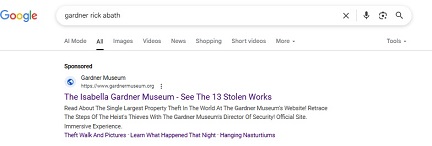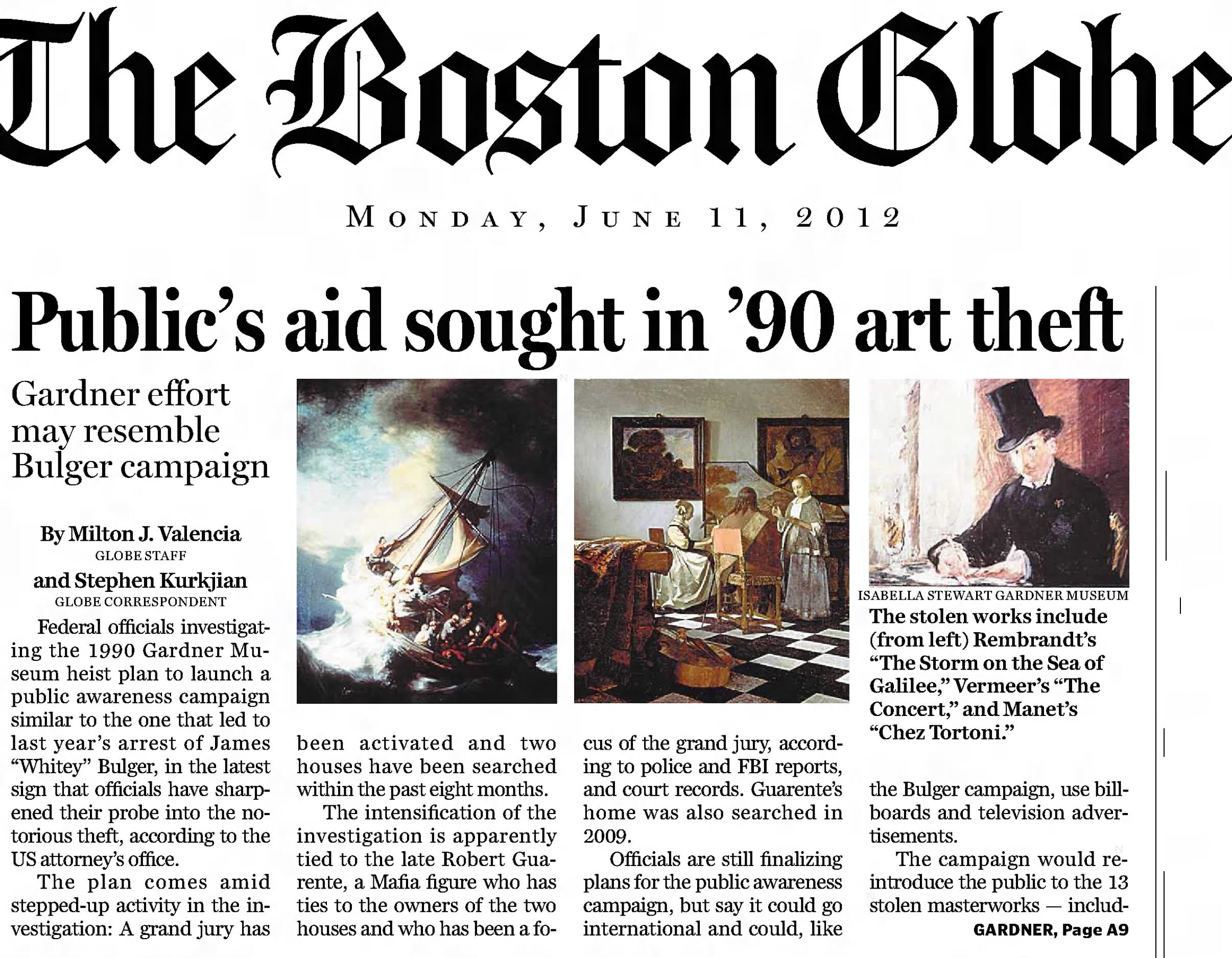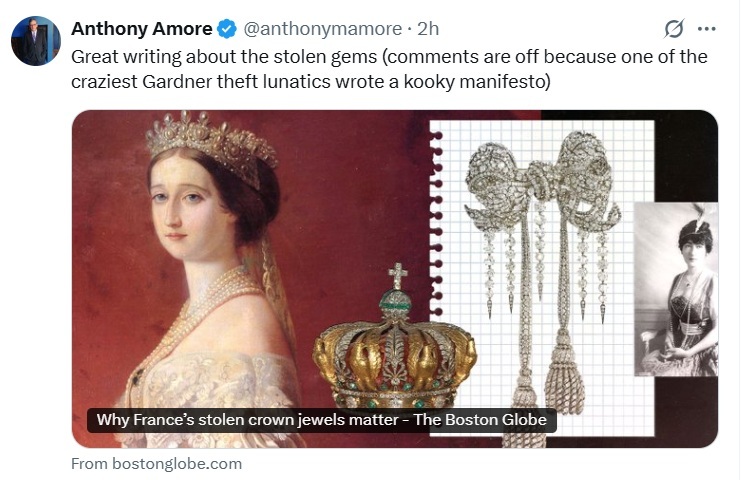Convicted spy Rod Ramsay as a potential Gardner heist suspect (Part Two)
 Clyde Lee Conrad on trial in a West German courtroom. Conrad was convicted on June 6, 1990
for his espionage activities while serving there on active duty in the U.S. Army,
and after he retired from the Army as a resident of West Germany
Clyde Lee Conrad on trial in a West German courtroom. Conrad was convicted on June 6, 1990
for his espionage activities while serving there on active duty in the U.S. Army,
and after he retired from the Army as a resident of West Germany
A Boston native, Roderick Ramsay was a member
of the Szabo-Conrad spy ring, for about two years, 1983 - 1985,
while stationed at the Army’s Eighth Infantry Division Headquarters in Bad Kreuznach, West Germany.
But Ramsay's criminal career did not begin with espionage. After his arrest, in June of 1990, the Washington Post reported
Ramsay admitted to invesitgators that he had robbed a bank in Vermont, and that
while working as a security guard in a hospital, he had attempted to break into a safe," FBI agent Joe Navarro testified at Ramsay's arraignment.
The Vermont bank robbery occured less than four months prior to Ramsay joining the Army,
and at a time when he was living just three miles from the Gardner Museum, in the Charles River Park apartment complex, overlooking Boston's Storrow Drive.
On August 28th of 1981, four men,
two armed with shotguns, and one in a getaway car keeping watch outside, robbed
the Howard Bank in Barton, Vermont of about $10,000.00.
Ramsay, who was only 19 years old at the time,
was said to be the mastermind
of the successful robbery. Ramsay's past run-ins with the law included charges for shoplifting and forgery.
The Szabo-Conrad spy ring was founded in 1967 by
Sergeant Zoltan Szabo, who recruited Sergeant Clyde Lee Conrad in 1974. Szabo lost his
top-secret security clearance in 1977 for selling government issue gasoline ration coupons on the black market. He retired from the Army two years later.
Conrad, whom Szabo had recruited in 1974, took over the espionage operation at that point.
Both Conrad and Ramsay worked as document custodians in the Division's G-3 [War] Plans section. Ramsay worked under Conrad both in his capacity as an Army Sergeant and
as a spy. Conrad "is believed to have managed at least a dozen people in the U.S. Army to supply classified information. It was one of the biggest spy rings since World War II,"
the U.S. Army Intelligence Command posted on Facebook in 2025.
The spy ring made millions of dollars, (nearly all of it going to Conrad) by stealing top-secret NATO and U.S. documents, and then selling them to Hungary and to a lesser extent, Czechoslovakia.
Conrad is believed to be one of only five American spies to have made more than a million dollars by way of espionage. What set both Conrad, and Ramsay, who was trained by Conrad,
apart from other spies, was their ability to recruit fellow soldiers to work with them in their espionage activities.
"Documents provided to Hungarian agents included NATO's plans for fighting a
war against the Warsaw Pact: detailed descriptions of nuclear weapons and plans for movement of troops,
tanks and aircraft."
"In addition to disclosing NATO wartime contingency plans," the New York Times reported, "the documents revealed key intelligence assets, including networks and safe houses in Germany used by American intelligence agents, according to officials. The Hungarians routinely share their information with the Soviet Union."
Ramsay had been perhaps its most prolific member, in terms of the sheer number of classified documents he managed to steal. Included in the "motherlode" of classified materials Ramsay
passed over to Conrad
were documents on the use of tactical nuclear weapons by US and NATO forces,
strategic plans for the defense of Europe in the event of an attack by Soviet and Warsaw Pact military forces, and manuals on military communications technology.
After ten plus years of the spy ring’s successful operation, however,
a senior member of the Hungarian Intelligence, Lt. Col. István Belovai, alerted NATO and the Americans
about a huge number of classified documents, being passed to Hungary, from somewhere in West Germany.
The classified documents included NATO battle plans, detailed descriptions of nuclear weapon locations and troop movements.
But before the investigation was complete, Belovai, who was under suspicion by Hungarian counterintelligence, was himself arrested in 1985, while making a pickup at a CIA drop in Hungary.
Before his arrest however, Belovai had provided a list of specific classified documents that had been shared with Hungarian intelligence, which allowed the Army to narrow
their focus on possible suspects to those who would have had access to them.
After a massive investigation, the Army was able to identify and prosecute most of the culprits. In the case of Clyde Lee Conrad however,
the U.S. Army had to work through West German authorities, where Conrad resided, since there was no extradition treaty between the two countries, for the crime of espionage.
The FBI first interviewed Ramsay about security breaches at Army Eighth Infantry Headquarters
on August 23, 1988, almost three years after he was honorably discharged from the Army. Only hours earlier that same day, German authorities had arrested
Conrad at gunpoint at home in bed with his wife.
"You vill take ze hands out of ze vife and place zem vere vee can
see zem," a German police investigator, Holger Klein, ordered.
The day of reckoning Conrad had feared for over two years had arrived, Stuart
Herrington, wrote in his book, Traitors Among Us : Inside the Spy Catcher's World.
Although this visit from the FBI was unexpected, Ramsay was not unprepared. When, at the end of the meeting, FBI agent Joe Navarro asked Ramsay if Conrad had ever given him
anything, Ramsay took from his wallet a mysterious slip of paper with a hand-written telephone number on it. Conrad had told him to use it in the future if he had to get hold of him, Ramsay
told Navarro.
Navarro carefully placed the slip of paper into an envelope, and brought it back to the FBI Tampa field office.
An FBI lab determined that the note given to Ramasay was written on a water soluble paper of a kind sold in novelty shops. It was known to be
favored by Eastern European intelligence services, as well. The paper
dissolved instantly, when exposed to any liquid, such as saliva, making it useful for rapid disposal and destruction of sensitive information in an emergency.
The telephone number was quickly identified as one belonging to the Hungarian Intelligence Service, by one of the other members of Conrad’s espionage gang,
Imre Kercsik, according to Navarro.
A Hungarian born physician, and Swedish national, Kercik served as a courier for the spy ring
and was arrested, along with his brother,also a medical doctor,
soon after Conrad.
But unlike Conrad, the two brothers cooperated with investigators.
The slip of paper given to Navarro by Ramsay represented hard evidence of Ramsay’s personal involvement in espionage. But while bringing Ramsay to justice was a priority, finding out
as much as possible about what Ramsay knew about the Szabo-Conrad spy ring was paramount; a matter of national security.
Understandably, the treatment Ramsay received by the FBI, compared with the handling
of an ordinary street-criminal might receive, for whom there was equally strong evidence of guilt, was
for that reason quite different.
But Ramsay was also treated differently from the other soldiers who were members of the Szabo-Conrad spy ring, perhaps owing to his level of involvement, his knowledge of the spy ring's operations,
as well as his willingness to cooperate, and his continued involvement in espionage and possibly other crimes, like perhaps the Gardner heist, when he returned to civilian life in the United States.
Continue
Convicted spy Rod Ramsay as a potential Gardner heist suspect (Part One)

Though his name has never been raised with the public as a Gardner heist suspect by either investigators or the news media, Roderick James Ramsay, a former Boston resident, arrested on espionage charges in Tampa, FL, on June 7, 1990, just ten weeks after the robbery, is certainly someone who remains worthy of consideration. Ramsay was convicted of espionage two years after his 1990 arrest and spent over a decade in prison after his conviction in 1992.
The Boston Globe, New York Times and other news media long ago abandoned hard reporting on the Gardner heist case in favor of “conjecture based on a
theory,” mutely disseminated by government officials
and their surrogates, like former FBI Gardner heist lead investigator Geoff Kelly, who in retirement has updated his narrative
(changed his story). He now claims that the security guard Rick Abath was indeed in on the robbery, after publicly suggesting otherwise
on numerous occasions for over twenty years. Kelly, who has a book on the Gardner heist investigation coming out in 2026, bases his conclusion on information known to investigators the first week; that the Museum security system did not record anyone going into the Blue Room gallery,
where Manet’s Chez Tortoni was taken, with the exception Abath, who was recorded entering the gallery twice.
As Kelly himself said on CBS Good Morning ten years earlier, in 2015: "Someone went into the
Blue Room that night, and the only one that went in that room that night was the security guard [Rick Abath], according to the motion sensor printouts."
But when Abath refused to speak with CBS Good Morning, and said publicly he was not doing anymore interviews, the FBI and its surrogates reverted to their false narrative that Abath was tricked into letting the thieves in.
By April of the following year, in 2016, the Gardner Museum’s secuirty director Anthony Amore, who is also
the FBI’s chief public relations surrogate on the case said:
“We have nothing to point at to say that he [Abath] was involved.”
Continue
The Gardner Museum's Disinforming Ad Campaign (Part Two)
False Facts In The Gardner Museum Audio Walk
Link to (Part One)

Text taken directly from the Gardner Museum Audio Walk appears in blue.
Amore: Thank you for joining me [Gardner Museum Security Direct Anthony Amore]
as we retrace the thieves’ steps—and find out what really
happened—on March 18th, 1990.

Gardner Museum "Heist" Ad August 20, 2025
This museum audio description of the Gardner heist does not describe "what really happened."
There are numerous false facts, and unsubstantiated claims
presented as facts, which showcase the museum's willingness to support the FBI's disinforming false narrative about the
Gardner heist, which seeks to explain the Gardner heist case as "the handiwork of a bumbling confederation
of Boston gangsters and out-of-state Mafia middlemen, many now long dead," while protecting Abath so long as he kept his mouth shut.
Silencing Abath had formerly been a top priority for the FBI, until he died in 2024. Now after twenty years of claiming that
Abath was not a suspect, the Boston Globe is reporting that the former Gardner heist lead investigator, Geoff Kelly is convinced that Abath was involved.
The museum audio also glosses over the utter lack of
any tangible basis for concluding there had ever been any actual investigation of the Gardner heist, as the term is generally understood,
or anything other than
the blocking of an investigation into what actually happened, by the FBI.
Let's begin. There was no equipment in the Gardner Museum in 1990 that could retrace the thieves' steps. There were electric
eyes in the door jambs of the galleries, which recorded when someone entered or exited some of the galleries and other
spaces in the museum.
This could be chalked up to a metaphorical description, but it has been repeated so many times over 15 years that
it gives an added measure of knowledge, and authority to what is known and being shared with the public. Most people
who have spent time learning about the case are surprised to learn that there was no equipment literally tracking the steps
of the thieves. At no time has anyone involved in the investigation made any reference to the electric eyes in the door jambs,
in speaking publicly about the case.
In 2009 the Boston Herald reported, "The thieves shut off a printer that spit out line-by-line data on any alarms
that would be triggered by movements in the museum.
But the computer hard drive still recorded their footsteps in the galleries."
No equipment "recorded their footsteps."
Continue
Amore: Two security guards were on overnight duty, as was typical. They’re stationed at a security area
downstairs.
In this case where the security guards were "stationed," and where they were in fact located were two distinctly different things,
when the thieves entered the building.
One of the guards was indeed located in the security station. He alone made the decision to let the thieves into the building.
At some point later, that guard called the other guard on
a walkie talkie, and asked him to return to the security station, he says, as he had been instructed to do by one of the
thieves.
"Inside the Venetian-palace-style building, two young watchmen were on duty.
One of the security men was seated at a guard’s desk in an office next to a door facing the Palace Road side entry.
The second guard was doing lengthy rounds within the compound,"
the Boston Herald reported in 2009. The guard was only ten seconds away on the stairs near the security station, when he was called
by the guard inside the security station, Rick Abath.
The Gardner Museum's Disinforming Ad Campaign (Part One)
For over two months now, at least, the Gardner Museum has been running Google paid search ads with keywords regarding the Gardner heist, covering an area at least 50 miles from the museum and out of state. Last month, for example, I entered: [gardner rick abath] into Google, and my search results included an ad for the Gardner Museum.
The landing page for the ad was a page on the Gardner Museum website with the header "Gardner Museum Theft: An Active and Ongoing Investigation."
Frequently there are large, what are called half-page ads, and two ads
on the same page in the Google search results. The ads are probably very inexpensive, since Google ad prices are based on an auction system, and no
one else is buying ads for the keywords [gardner heist], it seems.
But the Gardner Museum is spending some money to bring people to a particular page on their website about the robbery.
What is the point, exactly? The Gardner Museum's
"theft" page is consistently at or near the top of Google search results for "Gardner heist," for free as part of the
natural search results delivered by
the Google algorithm. So if you were to put [gardner heist] into Google, you stand a chance of Google returning results
with three of the top ten results being the Gardner Museum.

Gardner Museum "Heist" Ad June 22, 2025
Without
scrolling, the only thing displayed on the ad's landing page, which you arrive at if you click on the ad,
is a large photograph of the Gardner Museum Dutch Room. Then, further down is some dodgy history
about the theft, and finally, some pictures of the stolen art at the bottom of the page.
The ad itself has some false information in it, too. The headline includes: "See The 13 Stolen Works."
Apparently, the Gardner Museum assumes that everyone knows that none of the art has been recovered,
and that you can't see any of it. All you can see are photographs of the stolen items on this webpage, which is not the same thing.
There is nothing special about the photographs. These same images can be found in a lot
of places.
The ad also invites visitors to retrace the steps of the thieves. This, too, is false. There was no equipment in the
Gardner Museum at that time that recorded the steps of the thieves, or movement of any kind, most importantly
within any gallery.
Further down on the webpage, the Museum asserts that
"the facts are these: In the early hours of March 18, 1990, two men in police uniforms rang the Museum intercom and stated
they were responding to a disturbance.
This is not a fact. This is an uncorroborated and
updated account of what happened, taken from Rick Abath, the security guard who let the two thieves in. There are no witnesses
to what Abath claims were the words exchanged between him and the thieves he allowed in, except for the thieves themselves,
and The Boston Globe reported in March of 2025 that the Gardner
heist's own lead investigator for the previous 22 years, Geoff Kelly, is "convinced" that Abath was one of the Gardner heist thieves.
Abath is hardly someone whose statements can be accepted as "the facts."
In addition, Abath was initially interviewed by the Boston Police, and in their official report, it states that Abath told them that the
two fake cops said they were responding to the kids in the street after they were permitted inside the building.
He did not claim that the cops said they were responding to a disturbance until years later.
Next, the Museum says that "the guard on duty broke protocol and allowed them through the employee entrance."
Saying that he broke protocol suggests that breaking protocol was all Abath had done. If he was one of the thieves, which Kelly now says he is convinced is the case, then he didn't just break protocol;
he broke the law, and all this discussion of whether he was trained not to let anyone in, even cops, is moot.
"At the thieves’ direction, he stepped away from the security desk," the Gardner reports, but again, this
is the uncorroborated account of someone who is considered one of the perpetrators. There is no electronic footprint
of Abath's and the other thieves' actions and interactions.
"He and a second security guard were led to the basement of the Museum where they were restrained." More specifically,
he and the other guard
were led to the basement after Abath called the other guard on a radio and asked him to return to the security station, without telling him the reason.
This second guard was handcuffed and blindfolded with duct tape before being brought down to the basement, but we have only
Abath's questionable word that he too was led to the basement and restrained, since the other guard was unable to see.
They cut Rembrandt’s Christ in the Storm on the Sea of Galilee and A Lady and Gentleman in Black from their frames.
These two Rembrandt works were not cut from their frames. They were cut from their stretchers, which preserves more of the painting intact and
explains why they broke the frames.
Thomas Cassano, when he was the FBI's Supervisory Special Agent for the Gardner case, said that "the first two paintings
stolen were damaged. Rembrandt’s “The Storm on the Sea of Galilee” and “A Lady and Gentleman in Black”
were both taken from the wall, their frames smashed, and the canvases cut from their stretchers," Antiques and the Arts reported
in November of 2000.
Ten years later, Anthony Amore, security director for the Gardner Museum, said that
"they took a very sharp instrument we can tell by the grooves left in the stretchers," Amore
in an interview in 2010. If the paintings were cut from their frames, there would be deep grooves left by the thieves in the frames, not in the stretchers.
The fact that the thieves took the extra step, in the heat of a robbery, to cut the paintings from their stretchers instead of the
frames suggests, "How they went about removing the paintings – slicing them from their frames – that's indicative of a rank amateur when it comes to art theft," Kelly said in 2013.
But that fits the profile of the kind of individual the FBI was interested in pinning the robbery on, while not what actually happened
in fact.
Continue
Double Speak
Double Think
Double Plus Ungood For You

The time the FBI ran two condtradictory Gardner heist narratives on the same
day in the same place, in front of the entire national media and nobody said jack about it.
By Kerry Joyce July 2, 2025
On the anniversary of the Gardner Museum heist in 2013, the FBI held a press conference,
where the head of bureau's Boston office famously
announced that the FBI had identified the Gardner heist thieves.
"FBI agents had developed crucial pieces of evidence that confirmed the identify of those who entered the museum and others associated with theft,
but that "because the [23-year-old] investigation is continuing it would be 'imprudent' to disclose their names or the name of the criminal organization,"
With Soviet era servility the Boston Globe began their front-page coverage of the story by reporting that:
"Federal investigators, in an unprecedented display of confidence that the most infamous art theft in history
will soon be solved, said Monday that they know who is behind the Gardner Museum heist 23 years ago and that some of the priceless artwork was offered for sale on Philadelphia’s black market as recently as a decade ago."
Eight days later, however, the Boston Globe, in an unsigned editorial, contradicted the Boston Globe's own characterization of
the press conference in their reporting.
"Whether this is an expression of confidence
or desperation is anyone's guess," they wrote.
Twelve years and over a hundred Boston Globe newspaper articles later, in addition to a ten-episode Boston Globe podcast,
Last Seen
and a four-episode Boston Globe Netflix documentary (This Is A Robbery), and absolutely nothing to show
for it in terms of progress in the FBI's investigation,
what can we conclude? Was this FBI announcement,
an act of desperation
or of confidence?
There were definite signs of desperation by the FBI at the press conference. Their
progress report's most recent and definitive date concerned
the possibly sighting of some stolen Gardner art "about ten years ago." Why the ten-year wait?
Subsequent stories said the information had been brought to the FBI's attention three years earlier. OK then,
why the three-year wait?
And anyway, the Boston Globe had already done a front-page story about how the "federal officials investigating
the 1990 Gardner Museum heist plan to launch a public awareness campaign similar to the one that led to
last year’s arrest of James 'Whitey' Bulger," while the FBI and the Gardner Museum could not even be bothered
to say anything about it.

"Museum officials would not comment for this article.
But Amore sounded optimistic recently at a lecture at the Plymouth Public Library when he said he believed the works will be found,"
the Globe reported.
Desperate too
was the bureau's claim of knowing the identity of the thieves, but refusing to name them. DesLauriers said that
knowing the
identity of thieves was "opening other doors"
Wouldn't sharing that information with the public open even more additional doors?
The utter lack of any tangible progress in the twelve years since the 2013 press conference,
would seem to indicate that the event had not
been a prelude to an anticipated dramatic break in the case, at least one from the government or investigative side of things.
DesLauriers did say that "with today's announcement we begin the final chapter..." But that was twelve years ago
in a case that is 35 years old. As of today, the final chapter spans over one third of the time that the FBI has been
investigating it, and with little promise of it being resolved any time soon.
In terms of recovering the art, far from being something the FBI was desperate about, the FBI has shown time and again,
that it is not something they are desperate about all.
Consistently, the FBI had demonstrated they had other priorities
concerning the case than apprehending the criminals certainly, or even recovering the art.
In the 2005 Gardner heist documentary, Stolen, William Youngworth complained:
"The FBI takes this public posture that 'listen we just want the stuff back and we don't really care
how it comes back.' That's not true. I mean I have sat there behind closed doors and they only have one agenda
the only thing they want is names," and "they want an informant, more than they want the art back."
adding, "They give people passes for 19 murders,
you know, we're only talking about some pictures here."
Youngworth may have a point. There have been at least three known attempts by individuals to strike a deal for the
major pieces of the Gardner art, and in all three cases, the FBI has been credibly accused of interfering with a return.
One involved a ransom note the museum received in 1994.
Another was the case of the French criminals who offered to broker
a deal for some of the stolen Gardner art, which they claimed was held by
Corsican gangsters,
and a third was when William Youngworth offered to return the art but on advice of counsel,
demanded that he be given immunity from prosecution for anything related to the Gardner heist, a condition the feds
refused to accept, for Youngworth, while then extending a similar offer to Myles Connor twelve years later:
"For years convicted art thief Myles J. Connor Jr. boasted that he knew who committed the brazen art heist at the
Isabella Stewart Gardner Museum in 1990 and could help recover the masterpieces," the Boston Globe reported March 15, 2010.
"Last summer, federal prosecutors decided to find out if he actually knew anything."
"They gave Connor and a longtime friend, Edward J. Libby, letters of immunity that promised to shield them from criminal
charges if they helped recover the 13 stolen paintings and artwork, according to Connor, Libby, and Robert A. George,
a Boston criminal defense lawyer who engineered the agreement."
"But once again Connor came up empty-handed."
The immunity was extended to Connor in 2009, the same year Connor signed a deal with Harper Perennial (A division of Harper Collins)
to write a book about his lifetime of criminal exploits.
Called The Art Of The Heist, it was published in 2010.
It seems that the feds were desperate, but not for anything related recovering
the stolen Gardner Museum, but
as always for control of their false Gardner heist narrative.
What about confident?
Was the FBI's press conference "an unprecedented display of confidence," the case would soon
be solved?
The FBI did show a tremendous amount of confidence. Not that "a recovery was imminent," however, but
that DesLauriers, the SAIC of the FBI's Boston office,
could safely step outside of the FBI's
official and false Gardner heist narrative, like an astronaut leaving his spaceship to make needed repairs
to the outside of his craft,
and deliver a real world message to the Gardner heist thieves, and the public, and then go right back
to business as usual that very same day with their old pre-press conference narrative, confident in their power to
switch narratives as effortlessly as shifting gears in a Maserati,
without any grinding push back from the news media.
While DesLauriers was making his announcement, that day, that “The FBI believes with a high degree of confidence that in the years after the theft,
the art was transported to Connecticut and the Philadelphia region, and some of the art was taken to Philadelphia,
where it was offered for sale by those responsible for the theft.”DesLauriers added,
“With that same confidence, we have identified the thieves,
who are members of a criminal organization with a base in the Mid-Atlantic states and New England.” Meanwhile, the Gardner heist lead investigator,
Geoff Kelly, mingled with favored reporters, among those gathered there that same day, and
contradicted what DesLauriers was saying at the podium, he continued to promote and perpetuate the official story the FBI had
been developing, revising and perfecting over the previous dozen or so years.
At the time of the 25th anniversary in 2015, Anthony Amore Stealing Rembrandts co-author Tom Mashberg wrote that "Two years ago,
at a news conference in Boston aimed
at drumming up leads in the case, Mr. Kelly and Mr. Amore
outlined this theory, that it was the handiwork of a bumbling confederation of Boston gangsters and out-of-state Mafia middlemen,
many now long dead." That may have been what Kelly and Amore were saying to Mashberg, but that is not what Mashberg reported that day, and
it is certainly not what the SAIC of FBI's Richard DesLauriers was saying at the podium. While at the same press conference, the Gardner heist lead investigator, Geoff
Kelly
was working the room, and disseminating
a "theory" that contradicted what DesLauriers was saying.
In his story about the press conference in 2013 he reported that, "in an interview after the announcement, he [Kelly] was fully confident that the F.B.I. knew
the identities of the men who broke into the museum. He gave no additional information and would not say whether they were dead or alive."
So either Kelly did offer additional information and Mashberg did not report it and falsely reported that Kelly did not give additional information,
or he falsely reported two years later that "Two years ago,
at a news conference in Boston aimed
at drumming up leads in the case, Mr. Kelly and Mr. Amore
outlined this theory, that it was the handiwork of a bumbling confederation of Boston gangsters and out-of-state Mafia middlemen,
many now long dead."
"From my reading of this [Fox News] article,
retired Norfolk County prosecutor Matt Connolly wrote in the Patriot Ledger,"
"the FBI is still wandering around in the dark looking for a candle. [More like keeping people in the dark with something
they're calling a candle.]
FBI Agent Geoffrey Kelly said that because the paintings were sliced out of the frames 'that’s indicative of
a rank amateur when it comes to art theft.'
How does that square with knowing the identity of the thieves?" Connolly wrote. [The Fox News article quoted DesLauriers as saying
that "we have identified the thieves who are members of a criminal organization with a base in the mid-Atlantic states and New England."
"If you know who the thieves are, you know whether they are amateurs or not," he continued.
"Kelly also said about two of the thieves. 'They were clever in how they got into the museum,
but the working profile points to inexperienced art thieves.'
It seems to me if you know who they are you don’t have a 'working profile.' You know what their experience is."
"I’m cynical not so much because the FBI,
like the gangsters, treats truth like an overcoat to be used only when necessary," Connolly added.
"It’s because as Joe Friday would say, 'the facts don’t add up.'"
What was the precipitating event, which caused DesLauriers to step outside
of the FBI's own alternate reality, and make this announcement, one that was
significantly at odds with had been the official narrative of the case in recent years, continued to be the
official narrative for Geoff Kelly in speaking with Fox News and with
Tom Mashberg of the New York Times that day, and remains the official narrative to this day?
Continue
History's Worst Draft
By Kerry Joyce June 23, 2025
The Big Lie The Boston Globe won't stop telling about a key historical fact of the FBI's
Gardner heist investigation.
"Oceania had always been at war with Eastasia" —George Orwell "1984"
14 times
in the last ten years, and as recently as March 18, 2025, the Boston Globe has falsely and deceitfully reported that:
"In 2013 the head of the FBI’s Boston office [Richard DesLauriers] said at a
press conference that the agency knew who had pulled off the robbery and that both men were dead,"
as Kurkjian put it in
the December 27, 2015 edition of the Boston Globe.
In fact, the head of the FBI's Boston office did not say this in 2013.
The FBI changed their story. They did not claim that
the thieves were dead until two years later. What DesLauriers suggested
at the 2013 press conference was that the Gardner heist
thieves were still alive, and
still in control of the art as recently
as 2003.
For proof that the Boston Globe backdated the FBI's claim about the thieves being dead,
look no further than the Boston Globe's own news coverage on the day
of the March 18, 2013 FBI press conference.
And at the many references to the 2013 press conference, which appeared in the Boston
Globe prior to the August 7, 2015 Associated Press story, none which included anything about
the Gardner heist thieves being dead.
Continue
Copyright © 2025 All Rights Reserved kerry@gardnerheist.com
|
"Public enlightenment is the forerunner of justice and the foundation of democracy. Ethical journalism strives to ensure the free exchange of information that is accurate, fair and thorough. An ethical journalist acts with integrity." — Society of Professional Journalists Code of Ethics
"Sensationalism can override the truth of a news story." —Rick Abath 2015
"We’re really looking for what we describe as 13 perfect fugitives."
—Geoff Kelly, FBI Gardner heist lead investigator (now retired) and now author, and
a partner at Argus Cultural Property Consultants, from the podcast Inside the FBI June 23, 2023
Gardner Heist Aftermath
Post-Truth Makes Camp in the Athens of America (Part One)
 Read what the fuss is all about and the orginal
Read what the fuss is all about and the orginal
"kooky manifesto" comment here.
It Doesn't Add Up
1. "We have identified the thieves, who are members of a criminal organization
with a base in the Mid-Atlantic states and New England." Richard DesLauriers FBI Boston SAIC March 18, 2013
+2."I can't tell you specifics about the [Gardner Heist] thieves and what I know from them. All I can say about them is that they cannot lead us to the paintings today."
Anthony Amore Gardner Museum Security Director November 12, 2014
+3. The two individuals that took them and committed this crime are currently dead." Peter Kowenhoven FBI Boston Assistant SAIC March 18, 2015
+4. "In 2013 the head of the FBI’s Boston office said at a press conference that the agency knew who had pulled off the robbery,
and that both men were dead." —Stephen Kurkjian, Boston Globe December 27, 2015

Gardner Heist FBI
Quote of the Day
"Wow. It's easy to look back and say, well, the guard shouldn't have let them in. But it is a believable way to get into a museum, by having two guys dressed up as Boston cops responding to an alarm...
I can tell you that the guards are no longer considered suspects at this point."
—Geoff Kelly, FBI Gardner heist lead investigator (now retired) March 18, 2005
Gardner Heist / Art Recovery
Can anyone tell me the name of one suspect,
interviewed by the FBI in the year following the Gardner heist, besides
William Youngworth. Asking for a city.
Seven years later, Youngworth made the most public and tanglible offer to return the Gardner art, and was pursued by the Gardner Museum,
for years afterward in the hope of facilitating a return.
"While it may not point to a conspiracy, I remain intrigued as to how the FBI
could have muffed the investigation at several key points.
Why not focus on [museum guard] Abath more widely and intensively at the probe’s outset?"
Stephen Kurkjian Research Gate March 2019
"We know who did it."
—Geoff Kelly, FBI Gardner heist lead investigator (now retired) December 4, 2023
"We really have a good idea of how we think the heist went down back in 1990
and where the art work moved over the years, and individuals, who were responsible for the theft and may have
had some involvement... But again, I always temper that by saying that we could be wrong."
—Geoff Kelly, FBI Gardner heist lead investigator (now retired) June 23, 2023
"We know who did it."
—Geoff Kelly, FBI Gardner heist lead investigator (now retired) October 21, 2025
Repeat art fraudster arrested for stealing Courbet painting The Art Newspaper November 27, 2025
“The art world needs a database of people who have defrauded someone, who have not paid their debts or should not be traded with. A database like that would be a major deterrent to these kinds of crimes, getting the art trade closer to the standards of other industries, like banking and insurance.”
Four more arrested in $102M Louvre jewel heist, Paris prosecutor says
The two men and two women in custody are from the Paris region and range in age from 31 to 40, said the prosecutor, Laure Beccuau, whose office is heading the investigation.
—Associated Press November 25, 2025
Louvre spent too much on art and not enough on security, audit finds
The report was completed before the heist but noted persistent delays in renovations of the museum.
“The theft of the crown jewels is, without a doubt, a deafening wake-up call: this pace is woefully inadequate, these delays are far too long.”
—The Financial Times November 6. 2025
Louvre heist suspect is social media star and former museum guard, reports say
The suspect had worked as a security guard at the Pompidou Centre art museum. Abdoulaye N’s criminal record includes 15 offenses: possession and transport of drugs; and causing danger to others. He was also convicted of robbing a jewellery store in 2014.
—The Guardian November 5. 2025
French police arrest 2 Louvre jewel heist suspects amid manhunt
Both suspects are French nationals who live in a suburb of Paris. One of the suspects has dual citizenship in France and Mali, and the other is a dual citizen of France and Algeria. Both were already known to police from past burglary cases.
—GMA October 26, 2025
Arrests made over jewel heist at the Louvre, French prosecutors sayA huge police operation has been underway to locate the four thieves who were captured on camera making off with eight pieces from the museum in a daylight robbery early last Sunday.
—NBC October 26, 2025
‘It’s Got to Be an Inside Job’: Jewelry Thieves Weigh In on Louvre Heist
"The heist was far from a flawless operation. The thieves ditched gloves, a helmet, vest and other items that the authorities have said contained traces of DNA."
'They’re not experts,' he said. 'They’re opportunists.'
New York Times October 25, 2025
Louvre’s Director Says Key Camera Was Pointing Away From Jewelry Thieves
The museum’s director acknowledged on Wednesday that much of its security system was badly outdated and that the only exterior camera near the thieves’ entry point was facing away from them.
The security system kicked in only once the thieves had breached a window with power tools, shaving off crucial several minutes from the authorities’ response time.
New York Times October 22, 2025
Police probe new video showing Louvre jewel thieves escaping
"Investigators hunting the gang behind the heist have also found traces of DNA samples in a helmet and gloves, prosecutors confirmed.
NBC October 22, 2025

FBI Provides Update in Gardner Art Heist Case
November 21, 2000 W. Thomas Cassano, Supervisory Special Agent for the Gardner Museum heist case said that "a tape inside the museum showed the thieves making four forays through the galleries.
After taking the two Rembrandt oil paintings
in their first trip, they removed Jan Vermeer’s oil painting “The Concert,” Rembrandt’s etching “Self Portrait,” and Govaert Flinck’s painting “Landscape with an Obelisk” during their second."
Antiques and the Arts November 21, 2000
| |









 Read what the fuss is all about and the orginal
Read what the fuss is all about and the orginal
